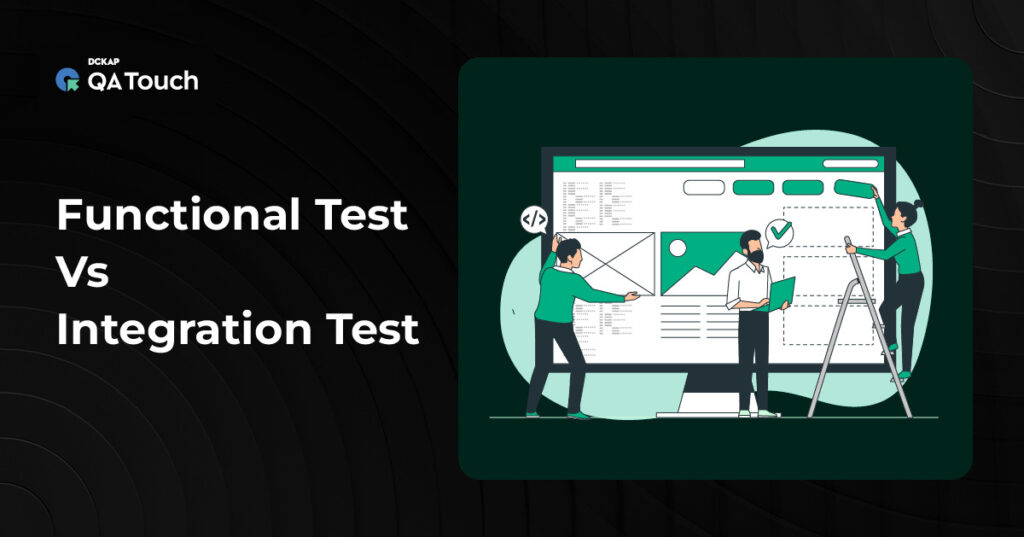Software testing is an essential step in ensuring reliable and high-quality applications. Among the various testing methods, functional testing and integration testing play critical roles in verifying software functionality and interoperability. But how do these two testing approaches differ, and how do they work together to achieve a seamless product?
In this blog, we’ll discuss in detail functional and integration testing, their objectives, differences, and when to apply each for maximum effectiveness in your QA processes.
What is Functional Testing?
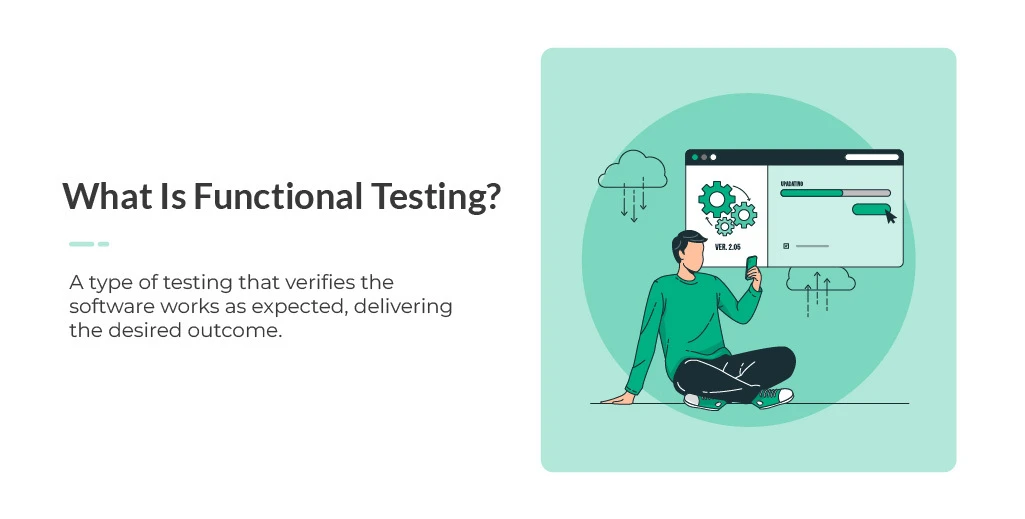 Functional testing is the process of verifying that a system or application performs its intended functions according to specified requirements. It ensures that every feature of the software works as expected and delivers the desired outcomes. This type of testing is conducted from the end-user’s perspective to ensure your application aligns with user needs.
Functional testing is the process of verifying that a system or application performs its intended functions according to specified requirements. It ensures that every feature of the software works as expected and delivers the desired outcomes. This type of testing is conducted from the end-user’s perspective to ensure your application aligns with user needs.
Key Characteristics of Functional Testing
- Focuses on individual functionalities or features: Each function of the software is tested in isolation to ensure it behaves as required.
- End-user perspective: Testing is performed as if by the end-user, emphasizing real-world usage scenarios.
- Black-box testing method: Testers do not need to know the internal code or implementation details.
Examples of Functional Testing
- Login form validation: Ensuring the login form accepts correct credentials, displays errors for invalid input, and handles edge cases like empty fields.
- Search feature: Verifying that a search bar returns accurate results based on user queries and filters.
What is Integration Testing?
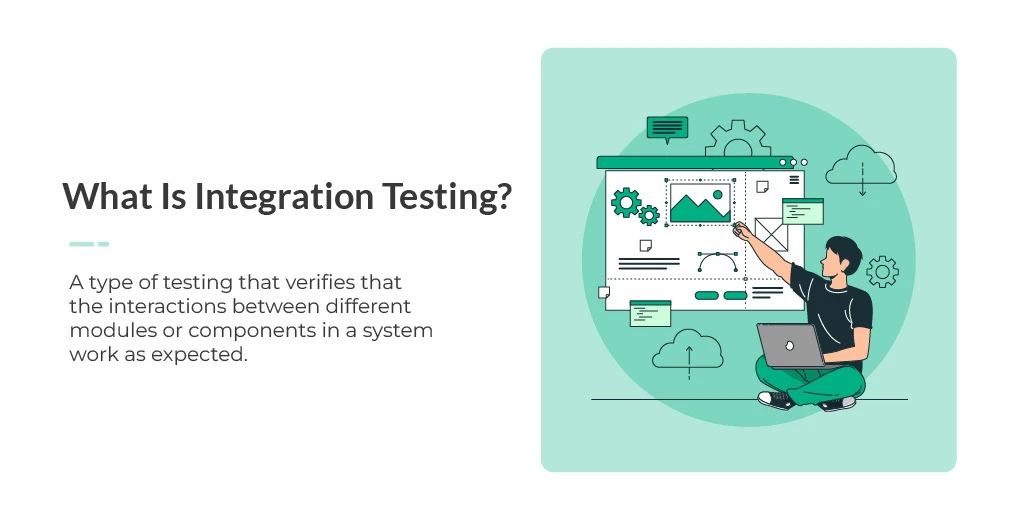
Integration testing is all about verifying that the interactions between different modules or components in a system work as expected. It goes beyond individual modules, focusing on how they communicate and exchange data to ensure a cohesive and reliable application. This type of testing is typically performed after unit and functional testing to identify issues that arise when modules are combined.
Key Characteristics of Integration Testing
- Focus on data flow and communication: You test how well the modules interact, ensuring smooth data exchange and functionality.
- Conducted after unit and functional testing: Integration testing builds on these earlier testing stages to verify combined functionality.
- Use of stubs and drivers: You might simulate missing components with stubs and drivers to isolate specific interactions during testing.
Examples of Integration Testing
- Payment gateway integration: Testing the interaction between an e-commerce application and a payment gateway to confirm successful transactions.
- Database and frontend display: Ensuring that the data displayed on the front end matches the information retrieved from the database.
Functional Testing vs. Integration Testing: Key Differences
Both functional testing and integration testing play vital roles in the software development lifecycle, but they serve different purposes. While functional testing ensures that individual features work as expected, integration testing focuses on the interactions between those features. To help you better understand these two types of testing, let’s break down their differences in detail:
| Aspect | Functional Testing | Integration Testing |
| Focus | Individual functionalities | Interactions between modules or systems |
| Testing Level | High-level testing for specific features | Mid-level testing between unit and system tests |
| Objective | Validate functionality against requirements | Ensure seamless communication and data flow |
| Tools | Selenium, QTP, etc. | JUnit, Postman (for APIs), etc. |
| Performed By | QA testers | Developers and QA testers |
Importance of Functional Testing
Functional testing plays a critical role in ensuring the overall quality of software. It ensures that each feature works as expected and meets the requirements, improving the product’s usability and reliability. Let’s break down why functional testing is so vital for the success of your software:
1. Ensures that all features work as intended
Functional testing verifies that every individual feature or functionality works according to its specified requirements. With functional testing, you ensure that the software behaves as expected in different use cases, ensuring a smooth user experience, whether it’s a login form, payment gateway, or search bar. Without functional testing, features might not work properly, leading to poor user satisfaction and an increased risk of errors.
2. Identifies defects early in the development cycle
By conducting functional testing during the early stages of development, you can spot defects early in the process. Catching bugs in their infancy allows you to fix issues before they snowball, which saves time, effort, and resources in the long run. This proactive approach also reduces the likelihood of bugs slipping through into later testing phases, making the overall development process more efficient.
3. Validate the software against business requirements
Functional testing is essential for ensuring that the software meets the business requirements and user expectations. It confirms that the application delivers the specific functionality it was designed to provide, which directly impacts the value it offers to users. By validating features against business objectives, you ensure that the software fulfills its intended purpose, helping achieve the desired outcomes for stakeholders and customers.
Importance of Integration Testing
Integration testing is a crucial step in the software development lifecycle that helps ensure the seamless functioning of the entire system. It focuses on verifying how different modules or components interact with one another. Let’s explore why integration testing is essential for delivering high-quality software:
1. Ensures seamless module interactions
Integration testing ensures that the various modules or components of a system work together as expected. While individual modules may pass unit or functional tests, they could face issues when interacting with others. Integration testing validates that data is passed correctly between these modules, and they cooperate seamlessly, which is critical for maintaining a smooth overall system operation.
2. Detects issues that arise from data flow and dependencies
When different parts of a system communicate, issues related to data flow and dependencies can surface. Integration testing helps identify these potential issues early. Whether it’s a mismatch in data formats or problems with APIs, detecting these issues before they reach later stages of development or production can save time and avoid costly fixes down the road.
3. Reduces integration-related failures during system testing or production
Integration testing significantly lowers the risk of integration-related failures during system testing or production. By testing the interaction between components early on, you can catch bugs that might otherwise lead to critical system failures later in the process. This helps ensure that when the system is fully integrated and tested, it operates as expected in real-world scenarios, avoiding disruptions or crashes in production.
When to Use Functional Testing?
 Functional testing is essential at several stages of the software development lifecycle. Here are some key scenarios where functional testing is ideal:
Functional testing is essential at several stages of the software development lifecycle. Here are some key scenarios where functional testing is ideal:
1. After Unit Testing is Completed
Once unit testing has verified that individual components work correctly in isolation, functional testing comes into play. You can now test how those components work together to ensure that the overall feature functions as intended. Functional testing ensures that the integration of various units aligns with the specified requirements and delivers the expected user outcomes.
2. When Validating Feature-Specific Requirements
Whenever you’re introducing a new feature or validating an existing one, functional testing should be conducted. This ensures that the feature meets the business requirements and works as expected from the end-user’s perspective. Whether it’s a login form, search functionality, or payment gateway, functional testing is key to confirming that each feature performs its intended task successfully.
3. For Testing New Functionalities or Bug Fixes
Functional testing is crucial when you add new functionalities to the software or implement bug fixes. By testing these changes, you confirm that the new functionality works as expected and doesn’t cause regressions in the application. It’s important to ensure that everything is functioning correctly before moving on to the next phase of testing.
When to Use Integration Testing?
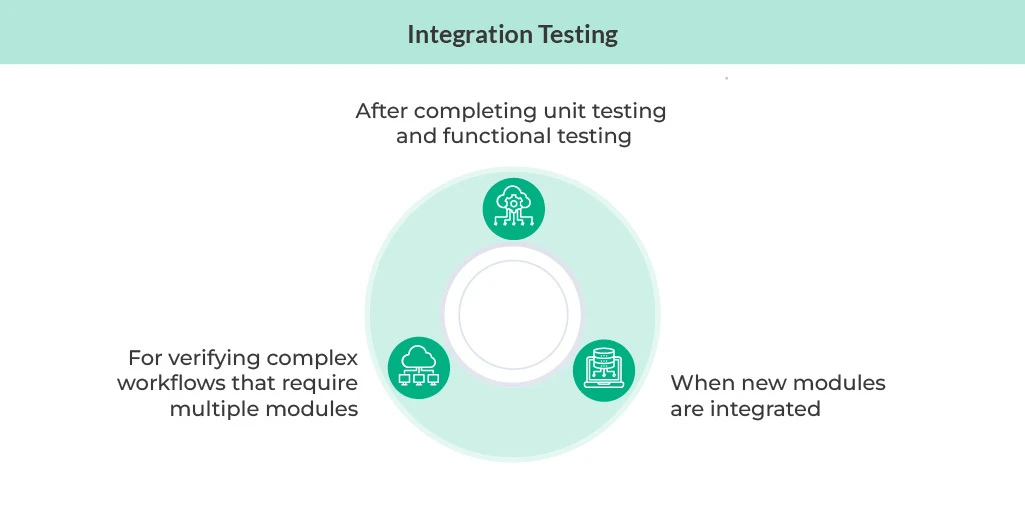 Integration testing is an important phase that ensures the smooth interaction between different components or modules of the software. Here are key scenarios where you should prioritize integration testing:
Integration testing is an important phase that ensures the smooth interaction between different components or modules of the software. Here are key scenarios where you should prioritize integration testing:
1. After Completing Unit and Functional Testing
Once unit testing has verified that individual modules or components work correctly in isolation, and functional testing has confirmed that features behave as expected from an end-user perspective, it’s time to focus on how these components integrate. Integration testing helps you verify that different modules interact seamlessly and that data flows correctly between them. This step is crucial to ensure the entire system functions as a unified whole before moving to system-level testing.
2. When New Modules Are Integrated into the System
Every time a new module is added to the system, integration testing should be performed to ensure it integrates correctly with existing components. Whether you’re adding new features or expanding the system, it’s essential to verify that the newly integrated module communicates properly with the rest of the system, doesn’t cause conflicts, and maintains data consistency across modules.
3. For Verifying Complex Workflows That Span Multiple Modules
Complex workflows often involve multiple modules working together to complete a task, such as a user purchasing an item through an e-commerce platform (involving a product database, payment gateway, and order management system). Integration testing is critical for verifying these end-to-end workflows and ensuring that all the modules involved collaborate effectively to complete the task as intended. Any issues in the flow between modules could break the entire process, so integration testing helps ensure these workflows function smoothly.
Functional Testing Process
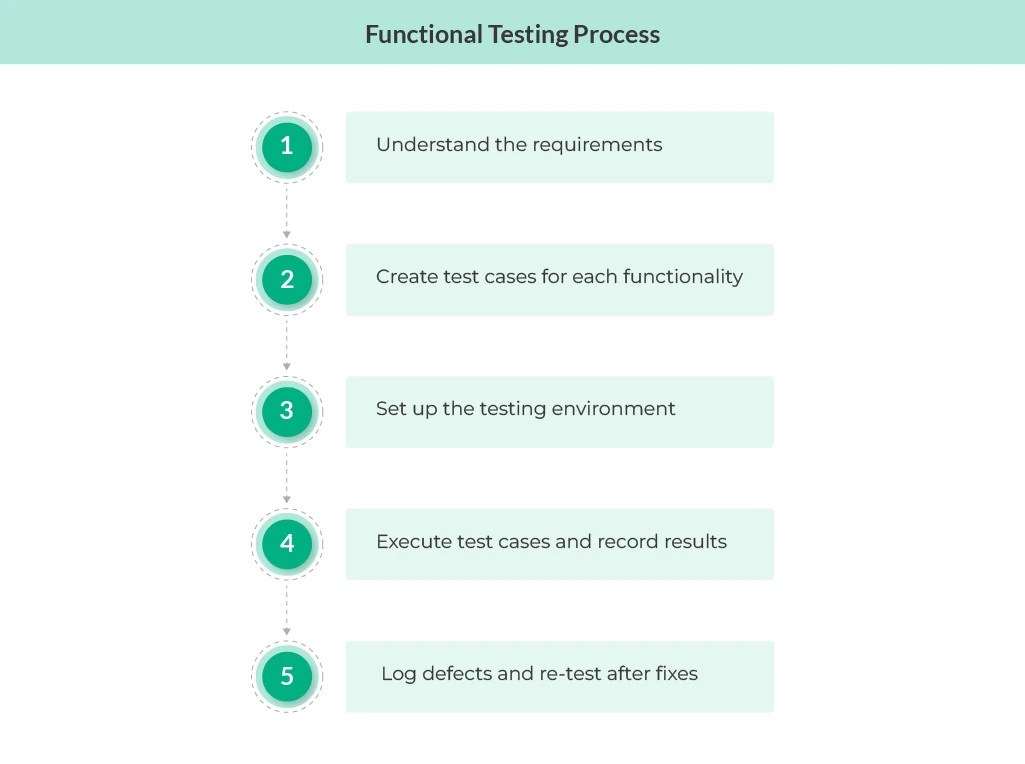 To effectively carry out functional testing, it’s important to follow a structured process. Below is a step-by-step breakdown of how to approach functional testing:
To effectively carry out functional testing, it’s important to follow a structured process. Below is a step-by-step breakdown of how to approach functional testing:
1. Understand the Functional Requirements
Before diving into testing, the first step is to thoroughly understand the functional requirements of the software. This involves reviewing the business requirements, user stories, and use cases. You need to know exactly how each feature is supposed to work and what the expected outcomes are from a user’s perspective. Clear requirements will guide your testing efforts and help you design meaningful test cases.
2. Create Test Cases for Each Functionality
Once you’ve understood the functional requirements, the next step is to create test cases for each functionality. Test cases define the conditions, inputs, expected outputs, and steps to validate that a feature behaves as intended. You should write test cases for various scenarios, including normal, boundary, and edge cases. This will ensure comprehensive coverage of the feature’s behavior.
3. Set Up the Test Environment
Before executing the tests, it’s essential to set up the test environment. This includes configuring the hardware, software, network, and databases required for testing. Make sure all the necessary tools and resources are available, and the environment replicates the real-world conditions where the software will eventually be deployed.
4. Execute Tests and Record Results
With the environment in place and the test cases ready, you can start executing the tests. During the execution, test each functionality according to the test cases and observe whether the software produces the expected results. As you execute the tests, be sure to record the results accurately, noting any discrepancies between expected and actual behavior.
5. Log Defects and Re-test After Fixes
If defects are identified during functional testing, they should be logged in a defect-tracking system with detailed information to help developers understand and reproduce the issue. Once the defects are fixed, the corresponding test cases should be re-executed to ensure that the fixes are effective and no new issues have been introduced. This iterative process continues until all defects are resolved, and the feature is fully functional.
Integration Testing Process

Here’s a step-by-step guide to performing integration testing:
1. Define Interfaces and Dependencies Between Modules
The first step in the integration testing process is to define the interfaces and dependencies between the various modules in the system. This involves identifying how each module communicates with others and what data is exchanged. Clear documentation of these interfaces helps you understand the relationships between components, which is vital for testing their interactions.
2. Prepare Test Data and Environment
Once the modules and their dependencies are identified, the next step is to prepare the test data and environment. This involves setting up data that simulates real-world scenarios and ensuring the environment mimics the production setup. The test data should reflect the kind of inputs and outputs expected during actual usage. Additionally, ensure the necessary tools and resources, such as databases, APIs, and servers, are configured for testing.
3. Use Stubs and Drivers to Simulate Missing Components
In some cases, certain modules or components may not be available during the integration testing phase, especially if they’re being developed concurrently. To address this, stubs and drivers can be used to simulate the behavior of missing components. Stubs mimic the functionality of a missing module, while drivers are used to initiate and control the module under test. This allows integration testing to continue even if not all components are complete.
4. Test Module Interactions and Data Flow
The core of integration testing is to test how the modules interact and whether the data flow between them is smooth and error-free. This involves checking that data is correctly passed between modules, APIs return expected responses, and communication protocols function as intended. Focus on verifying that all integrated modules work as a cohesive unit and that the system operates in a manner that meets the specifications.
5. Identify and Fix Integration-Related Issues
During testing, you may encounter issues related to module interactions, data mismatches, or unexpected behavior. It’s crucial to identify and log these integration-related issues so that developers can address them. Once the issues are fixed, re-test the integration points to confirm the issues are resolved and no new problems have been introduced. This cycle continues until the system operates seamlessly and all modules work together as expected.
Functional Testing Techniques
Below are some popular techniques used in functional testing:
1. Equivalence Partitioning
Equivalence Partitioning is a technique that divides input data into valid and invalid partitions, or classes, to reduce the number of test cases. Instead of testing every possible input, you categorize inputs into groups where the behavior should be the same. For each partition, you typically test one representative value. This helps ensure that the application handles different types of input correctly without needing to test each possible value.
Example: For a login form that requires a username between 5 and 15 characters, you would divide the input data into three partitions:
- Valid partition: 5 to 15 characters (e.g., “testuser”)
- Invalid partitions: fewer than 5 characters (e.g., “usr”) and more than 15 characters (e.g., “averylongusername”)
2. Boundary Value Analysis
Boundary Value Analysis focuses on testing the edge cases or boundary conditions at the limits of input ranges. These boundary conditions often reveal issues that might not be found with normal input values. Since errors tend to occur at the boundaries of acceptable input ranges, this technique helps identify problems that could arise near the limits.
Example: Continuing with the login form scenario, you would test the boundary values like:
- The minimum boundary (e.g., 5 characters: “abcde”)
- The maximum boundary (e.g., 15 characters: “abcdefghijklmno”)
- Values just outside the boundaries (e.g., 4 characters: “abcd” and 16 characters: “abcdefghijklmnop”)
3. Decision Table Testing
Decision Table Testing is a technique used when testing complex scenarios that involve multiple conditions and corresponding outcomes. It is particularly useful when there are several combinations of conditions that need to be tested. A decision table helps map inputs to the expected outcomes, ensuring that all possible combinations are tested.
Example: Imagine a discount system that offers discounts based on the user’s membership status and order total. You could create a decision table like this:
| Membership Status | Order Total > $100 | Discount Applied |
| Regular | No | No Discount |
| Regular | Yes | 5% Discount |
| Premium | No | 10% Discount |
| Premium | Yes | 20% Discount |
In this case, you would test all four combinations of membership status and order total to verify that the system applies the correct discount.
Integration Testing Approaches
Integration testing can be approached in different ways, depending on the needs of the project and the state of the modules involved. Choosing the right approach is crucial for ensuring that the system’s components integrate smoothly. Below are four common approaches to integration testing:
1. Top-Down Approach
In the Top-Down Approach, testing begins with the high-level modules or components, and the integration proceeds downward to the lower-level modules. The higher-level modules are tested first, often with the help of stubs (simplified representations of lower-level modules) to simulate the behavior of the missing components. As the integration progresses, stubs are replaced with actual modules.
Example: In an e-commerce application, you might start by testing the checkout process, integrating the shopping cart and payment system, while using a stub for the actual payment gateway.
2. Bottom-Up Approach
The Bottom-Up Approach is the opposite of the top-down method. Here, you begin testing the lower-level modules first and work your way up to the higher-level modules. Lower-level modules are tested in isolation and then integrated with higher-level modules as the testing progresses. If necessary, drivers (simulations of higher-level modules) are used to control the test.
Example: For a banking application, you might begin by testing the database interactions and account management modules, then gradually integrate with the user interface and transaction processing systems.
3. Big Bang Approach
In the Big Bang Approach, all the modules are integrated at once and tested as a whole system. This approach involves integrating the entire system and checking if everything works as expected. While it can be faster than incremental approaches, it often leads to difficulties in debugging and identifying specific integration issues.
Example: In a small project, you might integrate the backend, API, and frontend at once and test the entire system to ensure all components work together.
4. Incremental Approach
The Incremental Approach involves testing the system in smaller, more manageable steps. Modules are integrated and tested one by one, ensuring that each new addition works properly before moving on to the next. This approach can be either top-down or bottom-up, depending on the order in which modules are integrated.
Example: In a content management system, you might first integrate and test user authentication, then move on to content creation modules, and finally integrate the display modules.
Functional Testing and Integration Testing Example
To help clarify the differences between functional testing and integration testing, let’s consider a practical example involving a common feature: the “Forgot Password” functionality on a website.
Functional Testing Example
Functional testing focuses on verifying that the individual feature works as expected, based on the specified requirements, and from the end-user’s perspective. In this case, the goal is to ensure that when a user requests a password reset, the system behaves as expected.
Scenario: A user clicks the “Forgot Password” link on the login page and enters their email address to reset their password. The system should:
- Verify that the email exists in the database.
- Send a password reset link to the valid email address.
- Display appropriate success or error messages if necessary.
Test Case:
- Input: A valid email address (e.g., “user@example.com”).
- Expected Outcome: A reset password email is sent to the provided address, and a success message is displayed (e.g., “Check your inbox for a password reset link”).
- Error Handling: If the email does not exist in the database, the system should display an error message like “Email address not found.”
Purpose: The purpose of functional testing here is to verify that the “Forgot Password” feature itself works correctly and as expected, based on the specified requirements.
Integration Testing Example
Integration testing, on the other hand, focuses on the interaction between different modules or components of the system. In this case, the key interaction is between the backend system (which handles the password reset request) and the email server (which sends the reset link to the user).
Scenario: After a user requests a password reset, the backend system needs to interact with the email server to send the reset email. Integration testing ensures that the interaction between these two components works seamlessly.
Test Case:
- Step 1: A user requests a password reset, which triggers the backend to initiate the email sending process.
- Step 2: The backend sends the password reset request to the email server.
- Expected Outcome: The email server should receive the request and send the reset link to the correct email address. If there’s an issue in the integration (such as a misconfiguration with the email server), the email should not be sent, and an error should be logged.
Purpose: The purpose of integration testing in this case is to verify that the backend system and the email server interact correctly. The goal is to ensure that data flows seamlessly between the two systems and the expected behavior occurs when they work together.
Advantages and Limitations
In this section, we’ll discuss the advantages and limitations of both functional testing and integration testing to help you understand when and why to prioritize each type of testing in your development lifecycle.
Functional Testing Advantages
- Ensures feature reliability and correctness: Functional testing helps ensure that each feature of the application behaves as expected, providing confidence that the software will perform its intended functions without failure. This is key for user satisfaction.
- Easy to automate for regression testing: Since functional testing often revolves around verifying specific features, it is well-suited for automation. Automated functional tests can be reused during regression testing to verify that new code changes don’t break existing functionality.
- Focuses on user requirements: Functional testing is performed from the end-user’s perspective, which means it ensures that the software meets the business requirements and satisfies the user’s needs. It directly validates how well the system works for its intended purpose.
Functional Testing Limitations
- Does not cover interactions between modules: While functional testing is effective at testing individual features, it does not test how different components or modules of the application interact with each other. It misses the potential issues arising from component dependencies.
- May miss edge cases related to integration: Since functional tests are focused on features and functionalities, they might not always account for complex data flows and edge cases that involve multiple systems or modules working together. Therefore, issues that arise during integration may not be detected by functional testing alone.
Integration Testing Advantages
- Validates data flow and dependencies: Integration testing focuses on the interaction between different modules and systems. This helps ensure that data flows correctly across components, and any dependencies are properly handled. This is essential for a seamless user experience and overall system functionality.
- Identifies integration-related defects early: Since integration testing is done after individual components or features have been developed, it helps identify defects that occur when those modules work together. This allows issues to be addressed early in the development cycle, reducing the risk of more severe defects later on.
- Essential for end-to-end system reliability: Integration testing helps ensure that all parts of the system work together as a cohesive whole. This is crucial for achieving the overall reliability and stability of the application. Without integration testing, individual modules may work well in isolation but fail when interacting with other components.
Integration Testing Limitations
- Requires more effort and planning: Integration testing generally involves more complex setup and requires careful planning, especially in large systems with many dependencies. It often requires coordination between different teams, such as developers, testers, and system administrators, to ensure all components are properly integrated.
- Dependent on the availability of stubs/drivers: In some cases, certain modules may not be ready for integration testing, or they may be under development. To overcome this, stubs (to simulate missing modules) and drivers (to control the flow of higher-level modules) are used. However, this can introduce complexity, and if these stubs and drivers are not accurate or well-constructed, it can lead to unreliable test results.
Best Practices for Functional and Integration Testing
To maximize the effectiveness of both functional testing and integration testing, it’s important to follow some best practices that ensure thorough testing, efficiency, and smooth coordination across teams. Below are key tips to help you optimize your testing efforts:
1. Clearly Define Test Objectives
Before starting either functional or integration testing, it’s essential to have a clear understanding of the objectives. Know what you’re testing and why:
- For functional testing, ensure you understand the specific features or functionalities being tested and the expected outcomes.
- For integration testing, define the interactions between components or systems that need to be validated.
2. Use Appropriate Tools for Each Testing Type
Different types of testing require different tools. Using the right tools for functional and integration testing can improve both the quality and speed of your tests.
- For functional testing, tools like Selenium, QTP, and Cucumber are great for automating tests and validating UI/UX and functionality.
- For integration testing, tools like JUnit, Postman (for API testing), and SoapUI help in validating how modules interact and ensuring seamless data flow.
3. Automate Repetitive Tests Where Possible
Automation is a powerful strategy for enhancing testing efficiency, especially for repetitive tasks such as regression testing. Both functional and integration tests can benefit from automation:
- Functional Testing: Automate regression tests to ensure that previously tested functionalities remain intact after new features are added or bugs are fixed.
- Integration Testing: Automating integration tests helps in running repetitive checks for module interactions, especially in complex systems with many dependencies.
4. Maintain Updated Documentation for Test Cases and Results
Accurate and updated documentation is key to maintaining clarity and consistency in your testing efforts. This includes:
- Keeping track of test case documentation, which should describe what’s being tested, how, and the expected results.
- Recording test results and any defects found during testing, ensuring that issues are properly logged and tracked for resolution.
5. Collaborate Across Teams to Ensure Smooth Transitions Between Testing Phases
Testing often involves multiple teams, including developers, QA testers, and system architects. Collaboration is key to ensuring that the transition between functional testing, integration testing, and other phases is smooth.
- Communication: Ensure that all teams are aligned on the testing objectives, test cases, and timelines.
- Feedback loops: Provide regular feedback to the development team about issues found during testing so that they can be addressed promptly. Likewise, share feedback from integration testing to inform any changes in individual modules.
Conclusion
Both functional and integration testing are indispensable in delivering reliable, high-quality software. While functional testing focuses on ensuring individual features meet user expectations, integration testing ensures smooth communication and interoperability between modules.
By strategically combining these two methods, QA teams can identify and address issues early, paving the way for robust and user-friendly applications.
QA Touch is an efficient test management platform that takes care of your testing requirements from a single dashboard, thus elevating your QA process.
Sign up today. It’s free till you upgrade.

